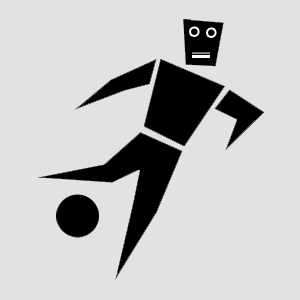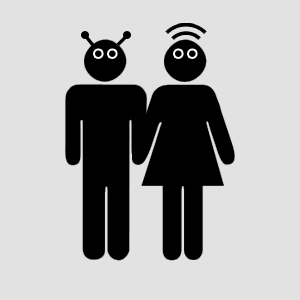Respect the Tech
19 Studies on How #technlogy Affects Our World
-
Cyberculture

-
Is it just a game?: Virtual crime, real results
Our society strives to make technological progress towards a cyborg future, where cyberspace and reality become entwined. However, our progress cannot be continued until virtual crime is addressed. To do this, I will first review Is There Such a Thing as “Virtual Crime”? by Susan W. Brenner to discuss the legal differences between virtual crime and real-life crime, and if there should be any difference at all. Next, I use an interview of a person who has been a victim of virtual crime to show how actions in cyberspace and reality are judged differently by society, thus halting our progress. Finally, I will end with the implications of this difference and how it will direct future research and discussion towards our goal of a cyborg future.
-
The cyberspace paradigm: Skype as a model for future communications
Advancing technology is rapidly showing us that the world is shrinking—with new communications technologies, people halfway across the globe are already at our fingertips. The Microsoft applicaiton Skype is foremost among these technologies, already being widely used for the purposes of international calls and messaging. This paper intends to build a model for future communications technologies and social networking communities by using Skype as a base. By evaluating Skype as part of a human-computer conglomerate through N. Katherine Hayle's definition of "cyborg" and discussing affordances unique to Skype as an application, I show the relevancy and impact of Skype on a model of future communications. By doing so, I hope to begin a conversation on both the feasibility and desirability of such a future while linking current tools to general paradigms.
-
*The philosohical troll: How cyberculture affects humanity
The imageboard 4chan has a reputation as one of the “worst” sites on the internet, due to the prolific vulgarity and strange customs that pervade its users’ posts. However, if we look deeper into the culture created by the site’s users, we find a very unique society enabled by a new form of communication that has some distinct advantages over other cultures. This paper uses Katherine Hayles’ concept of embodiment as an element of communication and other authors’ perspectives on technology as part of humanity to examine the unique form of communication that occurs on 4chan. Despite the lack of embodiment and personal identity that are crucial components of other cultures, the community has developed an extremely rich culture of its own. I argue that criticisms of 4chan’s harsh content and of technology-based societies in general are missing the unique positive qualities that the site offers, and conclude that 4chan is an important model of future internet-based cultures as the technology becomes more incorporated into society.
*Peer-selected for its currency and predictive power.
-
-
Tech Among Us

-
*Cyborg homes: Analysis of humanoid-infrastructure interactions in a cybernetic future
Smart homes today are homes which are equipped with technology that enhances our wellbeing, largely through the automation of processes that may detract from a satisfying living experience. As technology becomes increasingly sophisticated, I see that such homes are increasingly ubiquitous in our world today. To better understand where we are headed towards as we progress towards a cybernetic future, I look closely at the development of the cyborg home as the successor of the smart home. I do so by analyzing existing literature on smart homes and current products in the smart home market, which showcases its dissimilarity to my concept of cyborg homes. Thereafter, I will explore the idea of cyborg homes via two strands of thought: first, that the current views on cyborgs is compatible with the future juxtaposition of cybernetic technologies on homes; second, that our new cyborg capabilities will dramatically alter how we interact with our homes. I address possible concerns with such a vision of our future living spaces, before concluding with how such a vision spells out a future for humanity.
*Peer-selected for its originality and universal appeal -
The technological country club: How social media alienates underdeveloped countries
Twitter often gets praised for its ability to bring people together. Often neglected is the fact that a large portion of the world's population does not have reliable access to the site. Twitter and other social media platforms create an exclusive community, alienating a large portion of the world. I analyze two different approaches currently considered to be resolving this situation. Then, I will provide what I believe is a better solution to the issue, an international technological committee.
-
Not following the leader: How social media impacted the Arab Spring
People often comment on the impact that technology has on people's social skills. Frequently, this lens is used to analyze the limits of social media . However, this paper moves away from simple social skills and seeks out the effects that social media has in generating a greater kind of change, social change. This paper analyzes the impact that social media can have on revolutions in the twenty-first century and revolutions to come. I use the Arab Spring as a means to point out the strengths and weakness that social media forums can have on a revolution. Primarily looking at Twitter and the role that Tweets played during the Arab Spring, I outline the role that Social media can play in times of uprising. Like most things, moderation is key; While social media offers many benefits, in excess, it can generate chaos and present an apparent lack of directions. This ultimately raises the question of how will changes in technology change us and how we change humanity.
-
Cyborgism is Upon Us: Google Glass is Bringing Cyborgism to Consumer Culture En Masse
Where is humanity on the timeline between pure humanity and cyborgism? There are three answers to consider: first, that humanity already achieved cyborgism, possibly centuries ago; second, that humanity may need much more time to get there or may never achieve cyborgism; and third that humanity is right now approaching the point where it crosses into cyborgism. By specifically defining cyborgism and analyzing the implications of Google Glass, I conclude that the answer is the third school of thought: cyborgism is upon us.
-
-
Human Replacement in Entertainment

-
Preserving the human character of soccer: Analysis of human characteristics of soccer
The World Cup is one of the biggest sport events in the world; however, sometimes referees’ calls can ruin the game. One of the main example from the debate of this ambiguous judgment is adopting goal line technology. Some people say that the use of GLT(also known as goal line technology) could improve the decision of the umpires. Others claim that using this kind of technology will delay the game; therefore, we do not need it. However, not many people think about how the incorporation of technology with referees would make an impact on the human aspect of soccer. This paper analyzes the humanistic character of soccer by reviewing a controversial topic, referees with goal line technology. It will feature how technology could affect soccer and its humanism. In addition, using different data sets on the goal line detector could figure out why we need this advanced technology and why not. I will analyze this view from the perspective of Anti-Cyborgists, who has opposite opinion against technology to analyze the real meaning of soccer, by investigating the idea of referees use of goal line technology and how it affects the game’s philosophy.
-
Robotic musicians: The difference between "Robot" music and "human" music
Many people have looked into incorporating technology and music, but it seems that technology is changing the way people interpret at listen to music. Music has evolved into many different genres that changes what people are listening to. Most people listen to very basic elements of music while people who have had training in music look at it in depth. If technology is added to music, how much of the in depth analysis of music is lost? When technology is added to music is there still emotion in the music? I will be analyzing the difference between robotic music and music produced by humans. I will also be analyzing whether or not people are able to hear the difference between an ensemble full of musicians or an ensemble of just robots. A small study suggests that only a few people will be able to tell the difference between live musicians and robots. This is important because it shows the difference between the true nature of music and sound.
-
*Under further review: Instant replay and the human element of umpiring
Major League Baseball's snaillike implementation of instant replay in official games has drawn serious scrutiny. Criticism has come on all fronts from a variety of different viewpoints. However, very little, if any, attention has been paid to how the implementation of technological aids for umpires affects the humanity of the arbiters. Instant replay has been analyzed by the baseball establishment, sports media, statisticians, and more, yielding a wide variety of sources to pull from. In addition, general research done on cyborgs can be applied to baseball. I suggest that technological aids are not a problem in complex systems unless the human element is entirely removed, and that part of the appeal of baseball and other sports comes from their inherent imperfection. I analyze baseball's replay rules from a sporting and scientific perspective to synthesize a comprehensive picture of the effects of instant replay on the humanity of the umpires and the game as a whole. In addition, I propose altering the proposed rule changes to increase the benefits of the technology, as well as introduce other possible arenas for implementation.
*Peer-selected for its real-world impact
-
-
Human Identity in Aerospace

-
Turning bodies into spaceships: Human representation in space exploration
As human population continues to increase exponentially and resources become increasingly scarce, we face the problem of securing a future for mankind. A solution presents itself in the form of space exploration and the spread of humans off the planet we have always called home. However, humans are not adapted for living in space. This paper looks at the concept of cyborgs as a solution, beginning with the men who birthed the idea to how it has evolved over time till today and examines the current focus of the space agency NASA with regards to man in space through their Human Research Program. At the end, it finds that the focus today has shifted away from the cyborg solution and proposes that NASA, and even humanity as a whole, should reconsider the approach originally proposed and now made possible by technological progress.
-
*Hands-free extrasolar settlements: Exploring autonomous interstellar colonization
I discuss the viability of using artificial intelligence to create initially humanless colonies on exoplanets, as opposed to the traditional science fiction techniques of generational or sleeper ships. While it seems far-fetched, and admittingly so, current developments in artificial intelligence, as well as the writings of many futurists lends plausibility to both its viability and acceptance.
*Peer-selected for its radical argument, philosophical implications, and integration of space exploration and human development -
This is your captain speaking: The role of automation in the airline industry
Although modern aircraft have many computerized aids and autonomous functions to aid pilots, the unpredictability of human pilots may actually reduce the safety of air travel. Using the example of the Asiana flight 214 crash, I show that pilots may have become too reliant on autonomous features, and can no longer serve as effective backups when these systems fail. Instead, I propose that aircraft be fully autonomous, and that a network of the world’s best pilots be established so that in the event of a computer failure, the pilots can take control of the aircraft remotely and land it safely. Using the concept of a coupled system and weighing the social effects of this technology, I conclude that this system would make air travel safer and cheaper.
-
-
Living Healthier, Longer

-
*Choose the best for our children: Designer babies and the future of human enhancement
This paper examines the future technology of “designer babies” and the moral and ethical debate surrounding this topic. As a continuation of human enhancement, the practice of designer babies allows prospective parents to choose desired traits and features of their child, such as height, eye color, gender, etc. The current state of technology already endows us with the ability to diagnose diseases in embryos and even select the gender of our children. With great certainty, in the near future, designer babies would not only be a theoretical possibility but a practical technology. Thus, the question is no longer whether we could but the extent to which we are allowed to determine the fate of our children. This paper begins with a particular case of two parents pursuing genetic engineering to eliminate the possibility of their children having colon cancer. Based on a thorough review of various literature of the advancement of humanity through technology as well as the specific question of designer babies, it proceeds to address some major scientific, religious and social concerns regarding the application of designer babies, including the safety of the technique, the definition of humanity and the preservation of social equality. Finally, it concludes that designer babies, inevitably controversial but in fact beneficial, should be allowed for both treatment and enhancement. However, limitations should be placed when it comes to certain selection, even though the line is hard to draw.
*Peer-selected for its applicability -
Life or death: Radical life extension and the Indian kidney market
It seems almost inevitable that we will be able to increase our lifespans by several decades by the middle of this century, but the question remains whether we should do so. After summarizing the arguments for and against on many fronts, I use the example of the Indian kidney trade to argue that radical life extension will benefit those in developing countries proportionately less. Ultimately, this is the result of differences in the wealth of countries, and it is not likely to stop the development of radical life extension.
-
The quantified self: Improving lifestyle through self-monitoring
Humans engage in a practice where they want to learn more about themselves. They continuously push for data. Data about their sleeping patterns, eating patterns, work out patterns, etc. This thirst for knowledge has turned into mass improvement in the self. I argue that that I examine the data of an anonymous FitBit employee, who talks about what makes the product intrinsically beneficial for humans, Nicholas Felton, who creates an annual report to chart his routine activities, Jennifer Whitson, who elaborates about a process called gamification – the process of incorporating techniques from game design and game mechanics in non-game problem solving contexts. I argue that human’s drive to become more knowledgeable about one’s own self will cause humanity to integrate technology into its body and thereby allowing us as human’s more access to our personal information. I will also present the case that quantification leads to objective data which will have a huge impact in the medical field and healthy living.
-
-
Numbers and Economics

-
Numbers are tools: An anaylsis of numbers as technology
Numbers are used often in our everyday lives. We see them when we wake up. We use them as we drive to work or school. We use them when we go to the store or when we cook. These examples are just the obvious meetings with numbers in our lives. Numbers were used to build the houses we live in, the cars we drive, the roads we use, and the devices we use to see more numbers, like clocks or speedometers. Numbers are ubiquitous, and so, many people have studied them. However, even though many mathematicians have analyzed numbers as mathematical objects, not many have looked at the words that represent them. In this paper, I will analyze "number words" (such as "one," "uno," and "eins") and explain why they should be considered technology. In addition, I will examine the origins of some of these numbering systems and look at how they evolved to fit the needs of their users. To do so, I will draw upon Ruth Evans' broader understanding of technology as including mental frameworks. I will look at the analysis and study of the Pirahã language conducted by Michael C. Frank, Daniel L. Everett, Evelina Fedorenko, and Edward Gibson as an example of the importance of number words.
-
*In your face: The advent of consumer-oriented advertising
This paper examines the concept of targeted advertising and its effects on the psychology of the consumer under the assumption that it will become a part of all advertisements in the future by exploring to what extent these advertisements are beneficial to the world. By examining how Target Corporation goes about directing their advertisements at specific consumers and establishing their system as a working one, I look at authors and consumers opinions on this technology, which leads to a discussion of the breach of privacy. Seeing the effectiveness of this form of advertising despite public opinion, I conclude that targeted advertising is beneficial, providing other means of research that could be done to solidify this claim.
*Peer-selected for its depth and breadth -
Cyborg invalids: The link between automated technology and income inequality
In this paper, I explore the effectiveness of implementing technology to curb income inequality and unemployment in America. I also analyze the relationship of automated and integrated technology in the workplace and income inequality as well. Expenditures in education and government policies are both thoroughly compared in order to arrive at a conclusion if only more technology and a greater supply of skilled workers cannot produce net positive results. It ultimately appears that increasing the amount of technology and skilled workers in a nation are futile at curbing the inequality gap by any amount. Also, the argument that automated technology and higher tech skills can serve as a remedy is a circular, flawed argument; the wages of professionals are continuing to decrease, and their unemployment rates are increasing.
Note: The author of this paper preferred to keep it off the site.
-